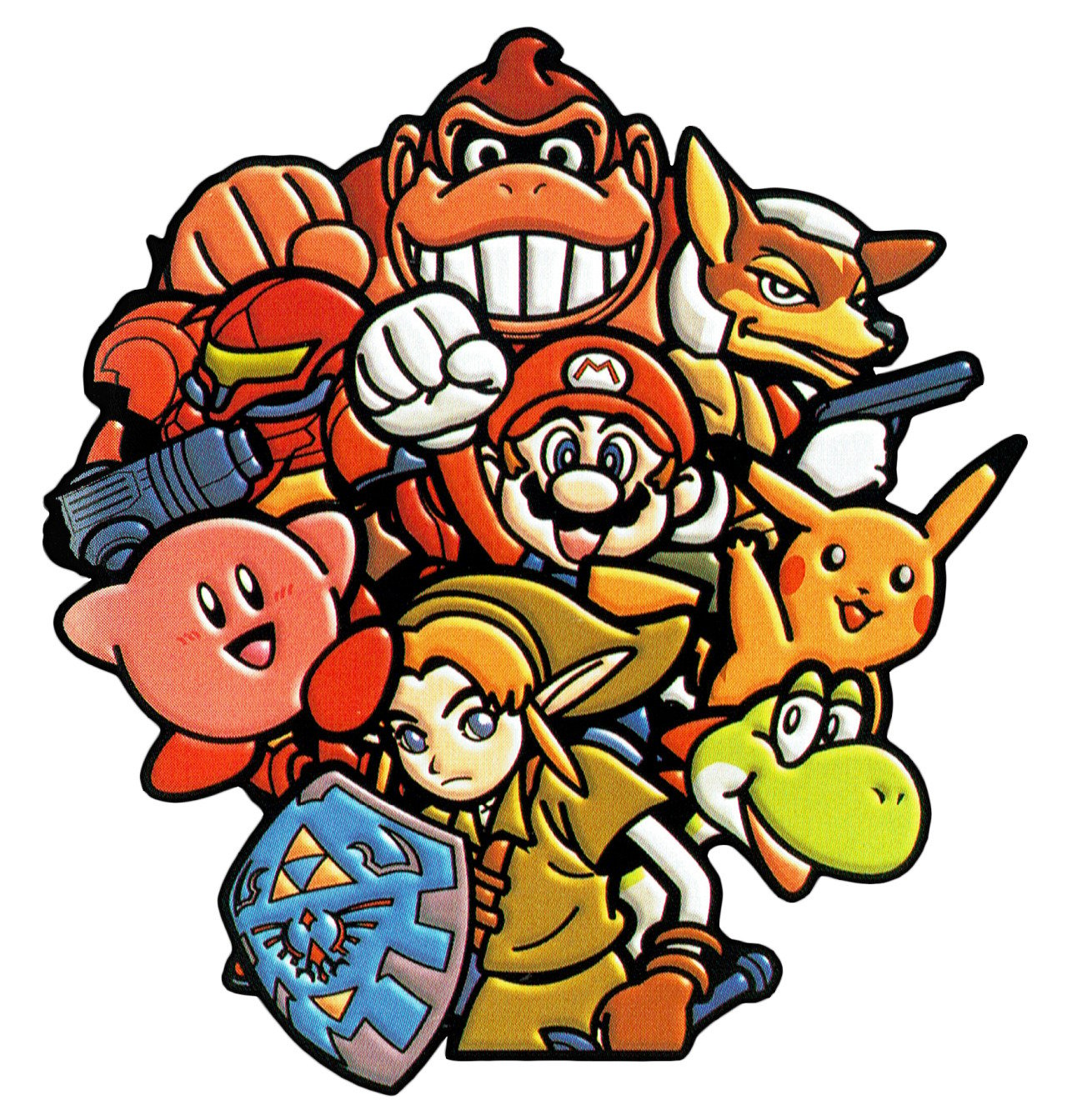Super Smash Bros.
For the article about the series, please see "Super Smash Bros. (series)".
| Template:FA-articleSuper Smash Bros. | |
|---|---|
| Super Smash Bros. | |
| Developer(s) | HAL Laboratory, Inc. |
| Publisher(s) | Nintendo |
| Designer(s) | Masahiro Sakurai |
| Released | Template:Europe November 19, 1999 |
| Mode(s) | Single-player, multiplayer (2-4) |
| Ratings | ESRB: E OFLC: G8+ |
| Platform(s) | Nintendo 64, iQue Player, Wii Japanese Virtual Console |
| Media | 128 megabit cartridge Flash Card (China) |
Super Smash Bros., known in Japan as Nintendo All-Star! Dairantou* Smash Brothers (ニンテンドウオールスター! 大乱闘スマッシュブラザーズ, Nintendō Ōrusutā! Dairantō Sumasshu Burazāzu), and often shorten as "SSB" and "SSB64", is the game that started the Super Smash Bros. game series. It is the predecessor of Super Smash Bros. Melee, and the pre-predecessor to Super Smash Bros. Brawl. It was released in Japan on January 21, 1999, in North America on April 27, 1999, and in Europe on November 19, 1999. It's playable on Nintendo 64 and the iQue Player and is available on the Wii's Japanese Virtual Console. A U.S. re-release is also planned for sometime in near future. A PAL re-release date is yet to be confirmed.
*Dairantou = Great Fray
Characters
There are 12 characters in SSB, eight of which are available from the start, and four of which are unlockable.
Defaults
Secret characters
Non-playable characters
Stages
- Peach's Castle
- Congo Jungle*
- Hyrule Castle
- Planet Zebes
- Yoshi's Island*
- Dream Land*
- Sector Z
- Saffron City
* These stages reappear in Melee as Past Stages.
Unlockable Stage
BRAWL stages
Adventure stages
Non-playable stages
Modes
1-Player
Multi-player
Tournament play
Unlike SSBM, SSB never enjoyed a "real" professional competitive scene, but interest in SSB has been renewed in recent years with the popularity of SSBM, SSBB, and SSB online through Kaillera using the Project64K emulator. Standard tournament rules differ little from that of SSBM. The most common standard tournament rules are as follows:
- Generally best 2 out of 3 (using 3 out of 5 or sometimes 4 out of 7 for finals)
- Double Elimination
- 5 stock
- 10 minute time limit, if it is possible, most emulators don't have time limit
- Items are turned off
- Handicaps are off
- The first match is selected randomly excluding Yoshi's Island, Sector Z, Planet Zebes, and Mushroom Kingdom.
- Mushroom Kingdom, Sector Z, Yoshi's Island are usually banned: Mushroom Kingdom for pipe spamming/edge camping, Yoshi's Island for cloud camping and projectile camping, and Sector Z for the size and the Arwing lasers. Planet Zebes is sometimes banned as well, for the acid.
- The loser of each match picks the stage for the next match excluding the illegal stages listed above.
- If Saffron City is selected on the first round and one of the players is using Ness, he or she may request a re-pick.
- However, if the Ness player wins the match, his/her opponent may counterpick Saffron City.
- The loser cannot choose a stage on which a previous match was played (known as "Dave's stupid rule"). Due to the low number of allowed stages in this game, this is often weakened to the loser cannot choose the stage on which the last match was played.
- For the first match, characters are chosen double-blind - at the same time, so that neither player knows their opponent's character beforehand.
- Players may re-pick characters after each match. However, the loser of each match gets to pick last (known as slob picks).
Online Play
Although Super Smash Bros. does not feature online play, emulators have the ability to do so. Project64k and Mupen64k are the most used emulators of playing online.
Trivia
- Congo Jungle, Dream Land and Yoshi's Island would later reappear in Super Smash Bros. Melee.
- Bowser, Mewtwo, and King Dedede were originally going to be playable or planned in this game but were removed due to time constraints (and in Dedede's case, Sakurai was worried about over-representing his own series). However, King Dedede was a background character in Dream Land in this game and Melee as well as a playable character in Brawl. Bowser was playable in Melee and Brawl, and Mewtwo was also playable in Melee. Many other characters were rumored to have been planned in the orginal game, such as Peach and Meowth.
- The starting eight characters are placed in the order of when they first appeared in their respective titles on the character selection screen, starting with the oldest Mario and Donkey Kong, and leading to the most recent, Pikachu.
- When a character is chosen, they perform a brief animation in their player's display box below the character-select array. This game is the only game in the series to have this feature.
- It was revealed in an interview with Nintendo's president, Satoru Iwata, that Masahiro Sakurai had intended for Final Smashes to be included in the original Super Smash Bros. He claims that he has proof in the form of recorded voices for when characters used their Final Smash. The idea, however, was never actually implemented until Brawl.
| Super Smash Bros. series | |
|---|---|
| Super Smash Bros. · Super Smash Bros. Melee · Super Smash Bros. Brawl · Super Smash Bros. 4 (for Nintendo 3DS · for Wii U) · Super Smash Bros. Ultimate |

